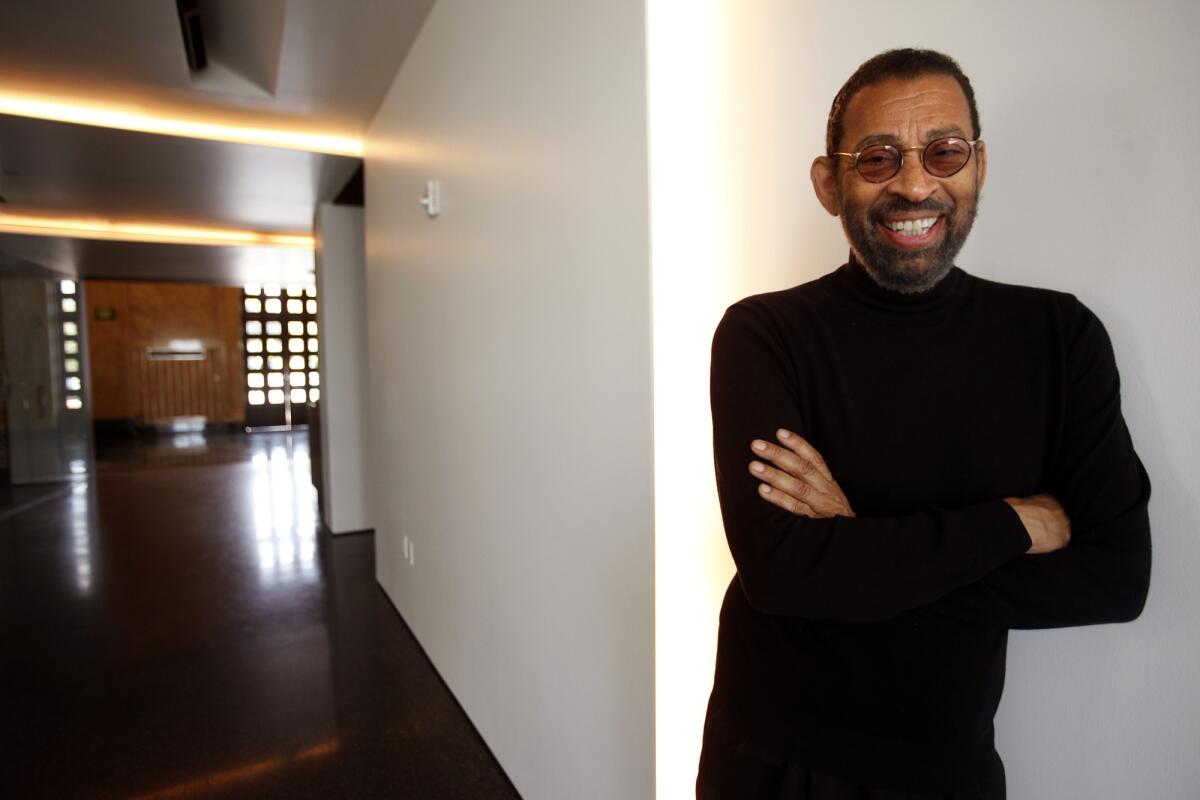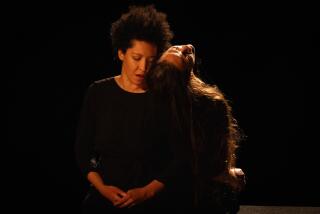Maurice Hines is ‘Tappin’ Thru Life’ with a fun and fearless outlook

- Share via
Onstage, in his striped Armani jacket, Maurice Hines looks like the zebra god, an ageless figure able to sing, dance and tell stories with equal aplomb.
Offstage, all in form-fitting casual black, he’s equally elegant and ebullient, talking about the show he’s brought to the Wallis Annenberg Center for the Performing Arts.
“Maurice Hines Is Tappin’ Thru Life” may sound like a one-man marathon for the veteran Broadway and nightclub headliner. But plenty of talent surrounds him at the Wallis, starting with the Diva Orchestra (a nine-member, all-woman band) and other, younger dancers tappin’ thru life. There are the brilliant Manzari Brothers, exploring the cusp between their teens and 20s, plus 11-year-old prodigy Luke Spring. The show continues through May 24.
------------
FOR THE RECORD:
Maurice Hines shows: In the May 15 Calendar section, an information box with an article about Maurice Hines’ show at the Wallis Annenberg Center for the Performing Arts in Beverly Hills gave incorrect times for afternoon performances on the weekend. The afternoon show on Saturdays is at 3 p.m., and the afternoon show on Sundays is at 2 p.m., through May 24.
------------
As Hines points out, this kind of multigenerational showcase is something of a tradition in the tap world, where the continuity of the art has always been a priority.
He laughs when asked whether, at age 70, he has trouble keeping up. “I had back problems starting when I was 20,” he says. “But you do it. Chita Rivera had a great song in her nightclub act called ‘Pain.’ But when you get out onstage the pain is gone. It’s the most amazing thing.”
“For me, it’s more fun than ever,” he says. “I’m totally fearless now. When you’re young you have a fear of whether the audience will like you, whether you’re singing the right songs — you have all this stuff. There is no more stuff for me now, no more fear.”
Though it becomes a running joke in the show, Hines says he never feels envious of younger dancers. “But I do sometimes feel sorry for them,” he admits. “I find that a lot of dancers are dancing for the paycheck and not for anything else. “
Touching his heart, he explains that dancing must come from a deeper place. And his new show certainly did, evolving to turn a great loss into a tribute.
“For me, it’s more emotional than exciting,” he says. “My brother’s gone, my mother’s gone and my father’s gone. And we were very close. I was very lonely after my father died three years ago. To be with my family on the stage, to talk about them and show all the pictures we had — my mother saved everything — makes me feel protected. I feel safe. I sing to them, and I dance with Gregory next to me in an empty spotlight — and I see his pictures up there.”
Gregory, of course, is the actor and dancer who teamed with Maurice (older by two years) in a brother act for many years before pursuing a solo career.
“His tap style never changed,” Hines says. “I was always into ballet and jazz. And I took some [Lester] Horton classes. I knew I wanted to be a choreographer, which I eventually became. Gregory knew I wanted to do that. But he always said, ‘I am a hoofer,’ and he was into improvisation, that’s what he did. He liked the freedom of it.” Gregory Hines died in 2003.
The history of their partnership is also, inevitably, a chronicle of apartheid in the entertainment world. Hines recalls a time in the 1950s when black entertainers could perform in major hotels on the Las Vegas Strip but had to live “across the railroad tracks on the black side of town” and go nowhere in the hotel except for the stage and dressing rooms.
“Even when the stars were black — Nat King Cole at the Sands, Harry Belafonte, I think, at the Riviera — they were not allowed to fraternize,” he says. “Ella Fitzgerald said she went from her room to the stage and from the stage to her room.”
Defying that reality brought bizarre consequences. During “Tappin’ Thru Life” Hines recalls an occasion a half-century ago when he went with Gregory for a swim at a Las Vegas hotel he declines to name. Instantly, he says, everyone else fled the pool area and the hotel quickly drained the pool.
Hines refuses to be bitter. “I remove myself from all kinds of negativity,” he declares. “It took me a while to get like that. But I won’t have it in my life.
“About 10 years ago I was trying to do a TV series about a black restaurant, I think it was at Universal,” he goes on. “We had a meeting and a producer was saying, ‘This show has to have more curse words because black people curse a lot.’ And this grandmother in the show was supposed to say this awful word. I said, ‘Listen I don’t know how many black people you know, but if I were even to think that, my grandmother would have knocked me into the next life.’ And then I said, ‘Would you excuse me for a moment?’ And I got in my car and went home.”
But most of Hines’ show-business reminiscences are laudatory, and a subtext of “Tappin’ Thru Life” is what he calls “a thank you to all the great artists who made it possible for Gregory and me to become what we did: Judy Garland, Frank Sinatra, Sammy Davis, Harry Belafonte, Lena Horne...” He calls Horne’s “The Lady and Her Music,” on Broadway in 1981 and ‘82, the greatest performance he ever saw.
Besides Hines’ reminiscences, the great revelation at the Wallis may be the way he creates a distinctive physical context for nearly all his songs through a gesture, a stance or maybe a simple dance-step, subtly transforming them into living sculptures. It’s a lost art — you won’t find it on “The Voice” or “American Idol.”
Hines was born in New York City and started tapping at age 5. Ever since, he’s seen and helped the art evolve through his career, Gregory’s and innumerable colleagues’ and students’, most notably Savion Glover, whom he discovered in a Washington dance class and later delivered to his brother, who was the ideal mentor, he says.
He sees the immediate future of tap as heavily influenced by Glover and all the dancers nurtured by his mid-’90s Broadway hit, “Bring in ‘Da Noise, Bring in ‘Da Funk.”
“I think that Savion was a great beginning,” he comments. “And he teaches all over the country. Dancers are being inspired by him. He looks like the kids today. But a lot has to do with his style of tap: into the floor, very street, very from the waist down. And that kind of tap is extremely hard and not everybody can do it.
“I don’t know. It will take a while to redefine itself and determine where it is and where it’s going. My mother always said ‘I don’t want to see the tricks onstage and I don’t want to see them offstage.’ It doesn’t matter what you do as long as you do it with class — she insisted on that — and the audience must always leave saying ‘I had a good time, baby.’
“That’s what I work for.”
-------------------------
‘Tappin’ Thru Life’
Where: Wallis Annenberg Center for the Performing Arts, 9390 N. Santa Monica Blvd., Beverly Hills
When: Through May 24. Tue.-Sat. 8 p.m. Saturdays 2 p.m. Sundays 3 p.m. and 7 p.m.
Tickets: $59-$129
Contact: (310) 746- 4000, https://www.thewallis.org
More to Read
The biggest entertainment stories
Get our big stories about Hollywood, film, television, music, arts, culture and more right in your inbox as soon as they publish.
You may occasionally receive promotional content from the Los Angeles Times.










